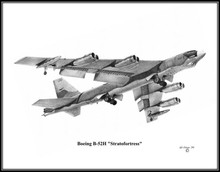 Loading... Please wait...
Loading... Please wait...- Home
- Combat Aircraft/Pencil Drawings ~ Free Shipping
- Boeing B-52H "Stratofortress" ~ Free Shipping
Product Description
Print Size 8½"x 11" ~ Unlimited print edition
The Boeing B-52 Stratofortress is an American long-range subsonic jet-powered strategic bomber. The B-52 was designed and built by Boeing, which has continued to provide support and upgrades. It has been operated by the United States Air Force (USAF) since 1955 and was flown by NASA from 1959 to 2007. The bomber can carry up to 70,000 pounds (32,000 kg) of weapons and has a typical combat range of around 8,800 miles (14,200 km) without aerial refueling.
After Boeing won the initial contract in June 1946, the aircraft's design evolved from a straight-wing aircraft powered by six turboprop engines to the final prototype YB-52 with eight turbojet engines and swept wings. The B-52 took its maiden flight in April 1952. Built to carry nuclear weapons for Cold War deterrence missions, the B-52 Stratofortress replaced the Convair B-36 Peacemaker. The bombers flew under the Strategic Air Command (SAC) until it was disestablished in 1992 and its aircraft absorbed into the Air Combat Command (ACC); in 2010, all B-52s were transferred to the new Air Force Global Strike Command (AFGSC).
The B-52's official name Stratofortress is rarely used; informally, the aircraft is commonly referred to as the BUFF (Big Ugly Fat Fucker/Fella). Superior performance at high subsonic speeds and relatively low operating costs have kept them in service despite the development of more advanced strategic bombers, such as the Mach-2+ Convair B-58 Hustler, the canceled Mach-3 North American XB-70 Valkyrie, the variable-geometry Rockwell B-1 Lancer, and the stealthy Northrop Grumman B-2 Spirit. A veteran of several wars, the B-52 has dropped only conventional munitions in combat.
As of 2024, the U.S. Air Force has 76 B-52s: 58 operated by active forces (2nd Bomb Wing and 5th Bomb Wing), 18 by reserve forces (307th Bomb Wing), and about 12 in long-term storage at the Davis-Monthan AFB Boneyard. The operational aircraft received upgrades between 2013 and 2015 and are expected to serve into the 2050s.














